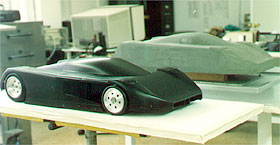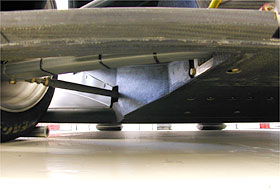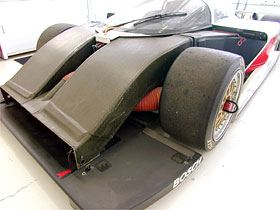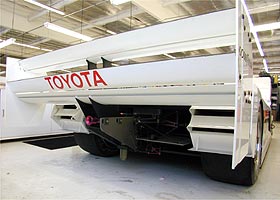|
|
|
| Prototyp : Car : Toyota Eagle MkIII - 16 FEB 02 : The Creators |
|
John Ward and Hiro Fujimori Introduction p1. Design philosophy p2. Aero (r)evolution p3. The chassis |
John Hutnick The Aero Model |
The MkIII, in detail Exterior Gallery Interior Gallery |
|
P: How did you tackle the wind tunnel testing of the Toyota MkIII, what scale and in what type of facility (rolling road or fixed floor, etc.)?
JW: That wind tunnel was the same 1/10th scale tunnel that we used to design the 1981 Pepsi car for Indy. It was built for a very low budget (we didn't have any money!), and yet was a very good tool. It had a rolling road and a vacuum system, all pretty much like we have now, just a much more modest scale. It just goes to show you what can be done if you just bear down and get on with it. Later on we had a chance to build larger scale models of the car and run them in Japan at the "Dome" facility. There were no real surprises, which speaks well for Hiro and his test methods. HF: Initially we used a our in-house, closed test section and the rolling road, 10% scale wind tunnel, that was originally built in 1979. The first MK III GTP wind tunnel test also utilized this same 10% wind tunnel. Then we employed a 25% scale wind tunnel for the further evolutions of the MK III GTPs with 20% scale wind tunnel models until end of the IMSA GTP series. The 25% wind tunnel had an open jet test section with rolling road also. |
 20% tunnel models being prepared |
|
P: The MkIII's aerodynamic concepts are quite unique compared to many of its contemporaries. For example, the MkIII's front underbody solution was very unique and, it might even be said, inspired today's generation of LMP race cars. What were the inspirations for the design of the MkIII? Were there any good ideas that didn't get applied to the car?
JW: As you state, the MKIII aero seems to be in use in most of the good closed wheel cars. It really does work! We got most of the good ideas into the car, including Dan's "Flip-Flop", a name we gave to his idea of flipping the water and air radiators from side to side. HF: The aerodynamics design of the MK III was the evolution of the accumulation of the knowledge and experience from Indy cars, IMSA GTUs, and GTOs. The MK III's front underbody preceded the evolutions from IMSA GTU front spoiler. AAR's IMSA GTU had small primary version front under body panel. The last version of AAR's IMSA GTO had a front underbody similar to MK III's. Also, the MK III's diffuser tunnel design employed the knowledge from our experience with Indy cars. We didn't miss any good ideas to apply at that time but we may have further pursued development of the vortex generators. |
 front diffuser ramps |
|
P: The MkIII appeared with subtle alterations over the several years it raced (1991 through 1993). How did the car evolve? Did downforce increase substantially from '91 to '93?
JW: The Flip-Flop shortened the plumbing, thus improving the throttle response, and we were able to get rid of the air intake snorkel. The engine air intake as well as all of the radiators and front brakes intake came in thru the one nose intake scoop. Very simple and neat! HF: A continuous evolution of the race cars is one of AAR's philosophy. After the successful debut of the MK III, we were still look for more downforce and lower drag. The first major evolution was a rearrangement of the cooling package. The turbo air intake moved to the inside of the intercooler air duct to eliminate the periscope type air intake for reduction of the drag. The second major evolution was the adoption of the Bi-plane rear wing and front nose winglet alternations. |
 cooling and intake air tunnels |
|
P: The MkIII first debuted with a relatively standard rear wing architecture (double element, low wing position, very large endplates). What was the immediate benefit of going to the "Red Baron" twin tiered, double element rear wing ala the Jaguar XJR-14?
HF: The immediate benefit was a reduction of the drag for the same level of downforce and aerodynamic balance. With the Bi-plane rear wing, the MK III produced 18% more downforce than the standard MK III. The standard rear winged MK III made 6760 lbs. of down force at 200 mph. The Bi-plane rear winged MK III made 7220 lbs. of downforce at 200 mph with the same drag as the standard MK III. Those forces figure are from the 20% scale wind tunnel data, though the onboard data acquisition system data showed considerably larger number than the wind tunnel data. P: Aerodynamically, how did the MkIII compare the preceding MkII? HF: Based on the 20% scale model wind tunnel test data, the MK III, as debuted makes 6760 lbs. of downforce and 1652 lbs. of drag at 200 mph. For comparison, the last MK II made 6569 lbs. of downforce and 1721 lbs. of drag at 200 mph. |
 bi-plane rear wing |
| MkIII: The chassis... > > |